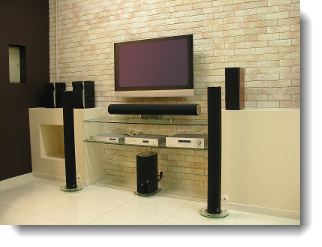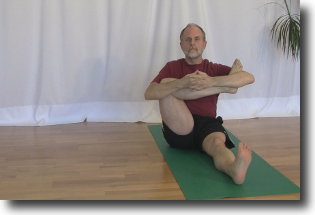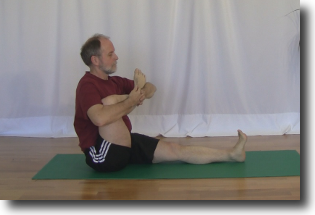Bob has been getting frustrated about how slowly the external rotation of his thigh in half bound lotus forward fold Ardha Baddha Padma Pashimottanasana. His heel is stuck part way up his leg. It refuses to get any closer to his hip, where it is supposed to be.
There is a pose that Bob can do while he is watching TV that will help to increase the flexibility of his hip. A lot of people call this pose “Rock the Baby” but I call it the “TV watching” pose.
What is the TV watching pose
The TV watching pose or the Rock the Baby pose is one a series of yoga poses that work specifically the external rotation of the thigh in the hip joint. It is a seated pose that you can do while watching TV, but you need to be sitting on the floor and not in your chair.
How to do the pose
You start out in Tadasana, sitting on the floor with your legs together and straight out in front of you.
From here you close your right knee and lift your right leg up so that your thigh is vertical and your shin is parallel to the floor. The knee joint will be at a 90 degree angle or a right angle.
Now you take your right arm and wrap it around your right knee. Your right elbow and knee should be together. At this point your spine is straight and you are hugging your knee into your chest.
Then you take your left arm and wrap it around your right foot. Your left elbow and your right foot should be together. You may be able to bring your hands together along your shin.
Once you have a hold of your right foot you lift it up so it is the same height as your right knee.
Now while you are sitting tall, draw your right knee in towards your right shoulder and bring your right foot towards your left shoulder. This movement of the right foot towards your left shoulder is working on the external rotation of your right thigh.
Now you are ready to watch TV. But you must stay sitting tall with your right knee being drawn towar
ds your right shoulder and your right ankle being drawn towards your left shoulder.
When a commercial comes on the TV, take your right ankle in both hands and bring it up towards your forehead. Once the commercial is over return your leg to its previous position and sit tall once more.
When the TV show is over, it is time to change legs and watch the next show with your left leg up in the air.
After watching a few shows like this, Bob will discover that his heel has come further up his leg in Ardha Baddha Padma Pashimottanasana than it ever did before.
Why do the pose
This pose focuses on the external rotation of the thigh in the hip joint while protecting the knee joint. It is this external rotation of the thigh that will let your heel move up your left leg and come against your hip and your knee will drop down on to the floor.
There is a tendency in Ardha Baddha Padma Pashimottanasana to pull the foot up the leg towards the hip further than it is ready to go. This movement will cause stress on the knee joint and could potentially hurt it.
When you have the thigh vertical and the shin parallel to the floor the knee joint is in a strong and stable position and the motion of bringing the right ankle towards the left shoulder works directly on the rotation of the thigh and does not try to twist the knee joint.
You will feel a stretching sensation in the muscles of your hip as you gently rotate the thigh and bring your ankle towards your shoulder.
You can still work on the external rotation of your thigh even if you can not get your shin close to your chest and shoulders.
What do you do if you cannot hug your knee and ankle in to your shoulders
Some people are not able to hug their knee and ankle into their chest right away. There are a couple of modifications that you can do in this situation.
Your knee is away from your shoulder
If you cannot get your thigh vertical you will not be able to wrap your elbow around your knee and hug it into your shoulder. In stead you can take a hold of your knee with your right hand and draw the thigh up to a vertical position. Even this action will help with the external rotation of your thigh.
Your ankle is away from your shoulder
The other problem may be that you can get your right thigh vertical but your right ankle is far away from your left shoulder. In this situation you take a hold of your right ankle with your left hand and gently draw it towards your left shoulder. Take care to make sure that your right thigh is vertical and that the knee joint is at 90 degrees.
You always want your shin to be at 90 degrees compared to your thigh. One of the common mistakes that you can make in this pose is to let the ankle drop towards the floor.
What are some mistakes to avoid
There are two common mistakes that you can make with this pose. The first is letting your ankle drop down towards the floor and the second is letting your back round.
Letting your ankle drop towards the floor
When you let the ankle drop down the shin is no longer parallel to the floor. In this position there is less rotation on the thigh and you are able in some cases draw your ankle into your ribs. You will think that you have succeed in this pose but that is not the case. Lift the ankle back up towards your shoulder and get your shin parallel to the floor once more. You will discover that there is some more external rotation left to be developed in your hip.
Letting your back round
You will quickly discover that when you do this pose it focuses directly on the muscles of your hips. You will also discover that if you round your back and let the top of your hips fall backwards towards the floor that you can relieve this stretching of the hip muscles. This is not a good thing.
The whole reason to do this pose is to stretch the muscles in the hip so that your thigh will externally rotate. If you round your back let your hips fall backward then the muscles of the hips stop stretching and you will not increase the external rotation of your thigh.
You need to keep your hips straight up and down. This will provide the maximum amount of stretch to your hip muscles.
If you find the stretch is becoming too intense you can get some relief by letting your ankle and shin move away from your left shoulder a little. After a brief break gently draw the ankle back into your left shoulder and resume the stretch.
Summary
Bob can use the TV watching posture to develop more flexibility in his hip while he is watching TV at home. You can get more external rotation in your thigh as well but you do not need to watch TV while you do this pose.
Next steps
Work with your teacher to insure that you are doing the pose correctly. Your teacher will help you to avoid the common mistakes that people make in this pose.






